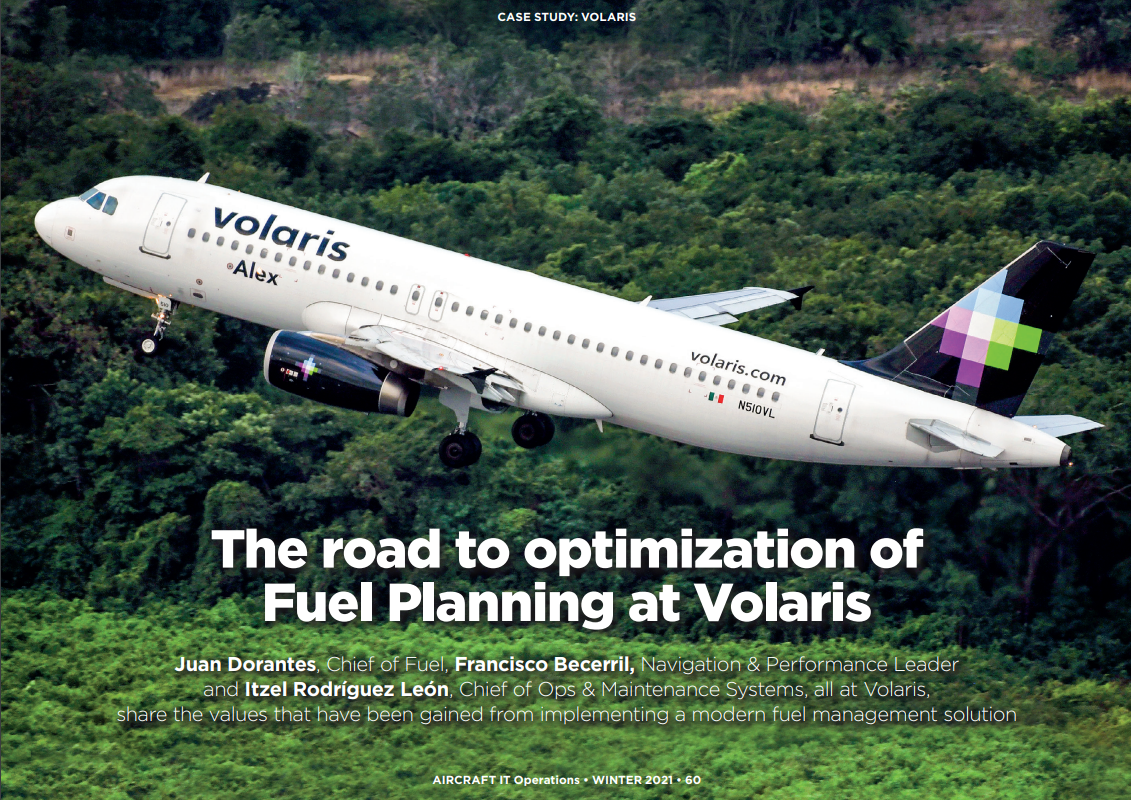The newest article in AircraftIT magazine with Volaris’ success story has just been released!
Juan Dorantes, Chief of Fuel, Francisco Becerril, Navigation & Performance Leader, and Itzel Rodríguez León, Chief of Ops & Maintenance Systems, all at Volaris, share the values that have been gained from implementing a modern fuel management solution.
Want to know more about Volaris’ success story with StorkJet’s Fuel Efficiency software, FuelPro? Then please read the full article or check out the link below.
Link to the full release of Aircraft IT Magazine

Before we go into the case study itself, it will be useful to look at the subject of the study, Volaris. The Mexican ultra-low-cost carrier started its operations in 2006. The airline provides point-to-point routes and builds its market with low base fares, offering high-quality services and a variety of choices for customers. Volaris caters to passengers visiting friends and family, cost-conscious business travelers, and leisure travelers as well. This young airline has grown rapidly in a short period and serves 70 destinations (Figure 1), connecting Mexico to the US, Central America, and Colombia with its modern fleet that consists of 97 aircraft, all from the Airbus family.

Despite the pandemic, Volaris is serving over one million passengers a month. The Mexican airline also successfully launched, last September, its new subsidiary airline Volaris El Salvador, the first ultra-low-cost national flag carrier. Volaris also has another subsidiary airline, Volaris Costa Rica, launched in 2016.
The basis of Volaris’s success and fast growth lies in its young and efficient fleet. Flying with 97 aircraft, from the classics A319, A320, and A321 to the new, efficient A320neo and A321neo. Another 25 A320neo are scheduled to be added by the end of 2022. These fuel-efficient aircraft will enable Volaris to take advantage of market opportunities and strengthen the airline’s leading position in the Mexican market. This fleet expansion has also aligned with the airline’s sustainability strategy to ensure industry and business viability in the future.
Volaris aims to always provide the best experiences to their customers while still taking care of the environment. With their sustainability strategy and the fuel efficiency software provided by StorkJet, the Mexican carrier can be easily classified as one of the most cost-efficient and eco-friendly airlines in the Americas, and on its path to more growth and success. This can be confirmed by several reports and certificates that Volaris can boast about:
• Company Integrated Annual Report
• SPO certificate from Sustainalitycs
• Bursatil certificates linked to emissions reduction and fuel consumption
Recognition of unusual tendencies
The process of the implementation of StorkJet’s fuel efficiency dashboard (FuelPro™) into Volaris operations began in 2019. It opened new doors when it comes to data analysis. Volaris has started a verification process of several fuel initiatives available in the FuelPro platform. One of the first cases that has been observed and analyzed was the case of Discretionary Fuel. Symptoms were quite unusual: pilots had been taking small amounts of extra fuel on board or nothing at all, which immediately raised additional doubts. It seemed as if almost all pilots placed unconditional trust in the planned fuel.
A detailed analysis has begun to find the reason for that state. Historical data has been monitored including initiatives that potentially could cause such indications.
Among others, discretionary fuel by Dispatcher and Company Fuel (Holding Fuel at Destination) has been verified. The outcome of those verifications was quite surprising: pilots felt comfortable with planned fuel as business rules that had been applied in flight planning system-imposed companies and dispatchers’ discretionary fuel overestimation. As it turned out, there was not enough reason for any more detailed analysis, nor there were tools to do so. FuelPro has opened the way for improved and efficient fuel planning.
In the pursuit of optimization
The next course of events was aimed to optimize the fuel planning process. It started with gathering feedback from pilots and consultations with the flight planning department. The main goal was not only to reduce discretionary fuel planned by dispatchers, as it would potentially increase pilots’ extra fuel taken.
The idea was to set such a balanced fuel policy tailored by route, aircraft type, and destination that no or little extra fuel would be required but on the other hand, pilots’ sense of safety would be uninterrupted.
When problems were identified, more time was devoted to detailed analyses of fuel planning activities. The key to successful communication was to have reliable data for analysis of specific flight phases, routes, aircraft types, pilots, or dispatchers. Of course, sensitive personal data are anonymized, but even with that, Volaris could still verify the case-by-case different behaviors.
When data analysis was ready, consultations with pilots, flight operations, and planning departments were started. Those consultations were aimed at reaching a newly optimized fuel policy that will not only reduce overburn caused by the cost of weight but also reduce unnecessary CO2 emissions. All components of fuel planned, and fuel taken onboard were analyzed, as well as all the related initiatives to make sure that the fuel planning is not only above the safety margins, but also is optimized where possible (where it’s not compromising safety).
The first initiative that was taken under the loop was the Company Fuel, also named Holding Fuel at Destination. The impact of changes in fuel planning policy caused significant reductions in planned fuel which is visible in Figure 2, the chart below (in yellow). At the same time, discretionary fuel taken by the captains (in turquoise) increased a bit, which was the expected reaction. However, the overall net value still shows a reduction of fuel on board by 600kg.

20k USD yearly savings per aircraft
Another fuel initiative that was analyzed is the Final Reserve Fuel, also called ‘Holding Fuel at Alternate’, which is also a component of the Planned Fuel.
Volaris has noticed that the amount of Final Reserve Fuel is highly overestimated. The Final Reserve Fuel should last for 30 minutes of endurance, however, from the charts below (Figures 3 and 4) you can see that it was planned for over 48 minutes of endurance, making it highly overestimated and resulting in almost 350 kg of extra fuel on board, and hence causing the fuel penalty of 15 kg per flight.


Final reserve planned A320-271 fleet
To calculate the Final Reserve Fuel, it is crucial to be aware that this Fuel, depending on the configuration of the Flight Planning System, can be either ‘Fixed’ or it can be ‘Calculated’. The ‘Calculated’ option is more optimal from the fuel efficiency perspective.
Going back to the graphs, with quick-change in-flight planning software impressive fuel savings were possible to be gained. The 15kgs of fuel penalty per flight mentioned above along with 1700 sectors yearly on average, corresponds to $20,000 savings per aircraft each year.
Reducing extra miles
Yet another component of the Planned Fuel and an initiative that was analyzed, is the so-called ‘Alternate Fuel’. Alternate fuel is the amount of fuel required from the missed approach point at the destination aerodrome until landing at the alternate aerodrome. Volaris started to analyze, case by case, a few of the most popular airports with the amount of extra fuel planned, and noticed some unusual tendencies. Namely, the amount of Alternate Fuel planned for the same alternate has increased substantially (Figure 5).

After thorough verifications, the reason for such a change has been identified. Aeronautic authorities for Mexico City Metroplex introduced new procedures for departure and arrival which in turn caused a dispatchers’ reaction to add extra miles providing safety in a new situation. Using FuelPro, Volaris has detected a new approach and stated that the increase of alternate fuel from ~1100kg to ~1500kg (as well as an increase in the distance planned from 148nm to 240nm) is disproportionate to the changes in procedures. Volaris started giving feedback inside the company, and in a few months, they were on the way to a steady state again.
A brighter future
As time has passed, Volaris introduced several improvements to their fuel management and planning to optimize fuel consumption. All feedback received through FuelPro has influenced not only the fuel policy applied but also other airline departments. Fuel efficiency managers receive visualizations of applied changes in the form of charts, dashboards, and tables.
Analysts were able to pinpoint areas that need improvement and pilot base managers were able to see which operational procedures and fuel conservation techniques have brought the best results. Evolving cooperation and mutual communications were steps necessary for the optimization process, which led us to a stage where the results are not only imagined but can finally be visualized.
Overall, the effort of Volaris in reducing the planned amount of fuel through various initiatives brought about a great effect. The planned fuel onboard was safely reduced (Figure 6) by approximately 1 ton focusing on various fuel initiatives, such as Alternate Fuel, Discretionary Fuel by Dispatchers, Final Reserve Fuel, and Discretionary Fuel imposed by company policy. The amount of Discretionary Fuel by Captain slightly increased because of these changes; however, captains still feel comfortable with the planned amount of fuel. Besides the increase in Discretionary Fuel (around 100 kg), the net result from this reduction is still super positive, 1000 kg less fuel onboard, which corresponds to an average of 64kg of fuel savings per flight.
Overall savings for 2021 thanks to more efficient fuel planning will equal 6.7m USD. With that Volaris reduces yearly CO2 emissions by 31 000 tones.

More to come
As this is not the end of the journey, Volaris and StorkJet are looking forward to further cooperation in seeking more improvements in the field of optimization of fuel consumption and, most importantly, CO2 emissions.
Fuel planning initiatives are not the only ones that can provide improvements in the field of efficiency. The charts represent yet another example of savings generated through FuelPro’s implementation. The first chart presents the percentage of departures with High and Low acceleration altitudes performed at SJO airport.

Volaris has introduced a new policy in which its main assumption is to use low acceleration altitude on departures instead of high acceleration. Results of that policy change prove that since November 2020 low acceleration was used on 94% of departures, compared to only 7% before the change of policy. The second chart (Figure 8) presents results before and after the implementation of that change. Departure fuel dropped giving 37kg savings on every single departure.

FuelPro provides over 44 fuel initiatives where savings can be achieved. They concern not only Fuel Policies, but also other fields like Flight Planning, Ground Operations, Flight Path Optimization, and many more.
 Juan Dorantes is an Aeronautical Engineer, experienced in Flight Safety, and currently responsible for the Fuel and Emissions reduction program.
Juan Dorantes is an Aeronautical Engineer, experienced in Flight Safety, and currently responsible for the Fuel and Emissions reduction program.
 Francisco Becerril is an Aeronautical Engineer and Licensed Flight Dispatcher with 15 years of aeronautical industry experience, in charge of redesigning airspace and routes optimization for Volaris.
Francisco Becerril is an Aeronautical Engineer and Licensed Flight Dispatcher with 15 years of aeronautical industry experience, in charge of redesigning airspace and routes optimization for Volaris.
 Itzel Rodriguez Leon has a Bachelor’s degree in Computer Engineering from Instituto Tecnológico de México. She leads governance on TRAX and Storkjet software and was Project Manager implementing Fuel Pro and APM.
Itzel Rodriguez Leon has a Bachelor’s degree in Computer Engineering from Instituto Tecnológico de México. She leads governance on TRAX and Storkjet software and was Project Manager implementing Fuel Pro and APM.
![]() Volaris is a low-cost Mexican airline based in Mexico City, Guadalajara, and Tijuana. The airline offers scheduled flights across the Americas, mainly offering domestic flights within Mexico and international flights to the US
Volaris is a low-cost Mexican airline based in Mexico City, Guadalajara, and Tijuana. The airline offers scheduled flights across the Americas, mainly offering domestic flights within Mexico and international flights to the US
